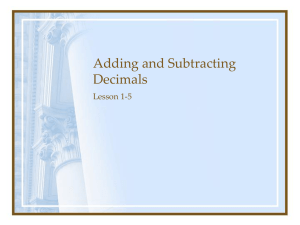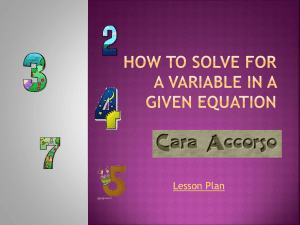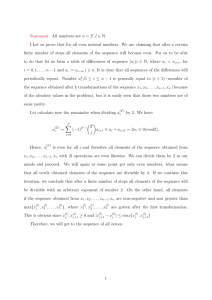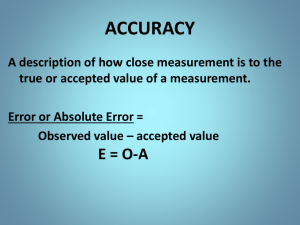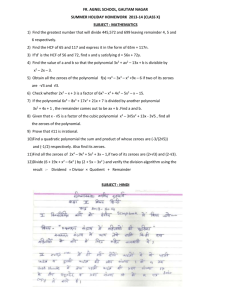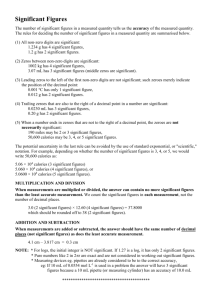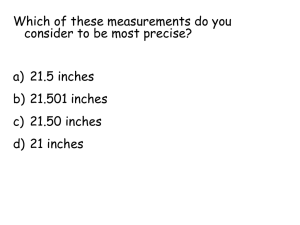n_cn_c_9_lesson_complex_zeros_of_quadratics
advertisement
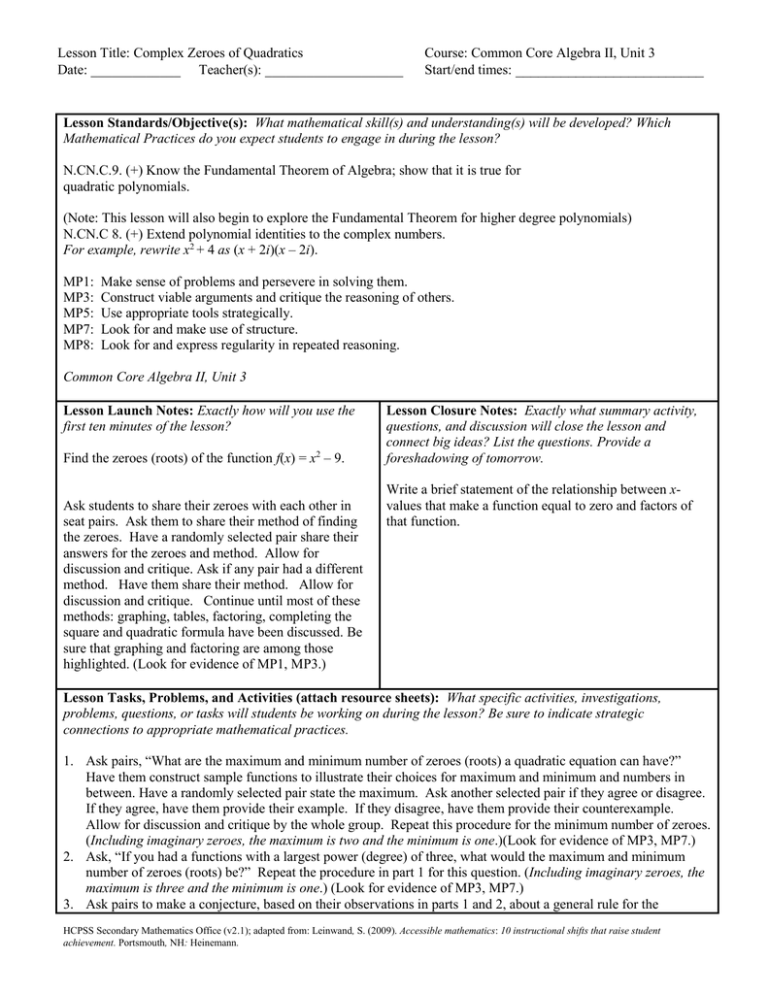
Lesson Title: Complex Zeroes of Quadratics Date: _____________ Teacher(s): ____________________ Course: Common Core Algebra II, Unit 3 Start/end times: _________________________ Lesson Standards/Objective(s): What mathematical skill(s) and understanding(s) will be developed? Which Mathematical Practices do you expect students to engage in during the lesson? N.CN.C.9. (+) Know the Fundamental Theorem of Algebra; show that it is true for quadratic polynomials. (Note: This lesson will also begin to explore the Fundamental Theorem for higher degree polynomials) N.CN.C 8. (+) Extend polynomial identities to the complex numbers. For example, rewrite x2 + 4 as (x + 2i)(x – 2i). MP1: MP3: MP5: MP7: MP8: Make sense of problems and persevere in solving them. Construct viable arguments and critique the reasoning of others. Use appropriate tools strategically. Look for and make use of structure. Look for and express regularity in repeated reasoning. Common Core Algebra II, Unit 3 Lesson Launch Notes: Exactly how will you use the first ten minutes of the lesson? Find the zeroes (roots) of the function f(x) = x2 – 9. Ask students to share their zeroes with each other in seat pairs. Ask them to share their method of finding the zeroes. Have a randomly selected pair share their answers for the zeroes and method. Allow for discussion and critique. Ask if any pair had a different method. Have them share their method. Allow for discussion and critique. Continue until most of these methods: graphing, tables, factoring, completing the square and quadratic formula have been discussed. Be sure that graphing and factoring are among those highlighted. (Look for evidence of MP1, MP3.) Lesson Closure Notes: Exactly what summary activity, questions, and discussion will close the lesson and connect big ideas? List the questions. Provide a foreshadowing of tomorrow. Write a brief statement of the relationship between xvalues that make a function equal to zero and factors of that function. Lesson Tasks, Problems, and Activities (attach resource sheets): What specific activities, investigations, problems, questions, or tasks will students be working on during the lesson? Be sure to indicate strategic connections to appropriate mathematical practices. 1. Ask pairs, “What are the maximum and minimum number of zeroes (roots) a quadratic equation can have?” Have them construct sample functions to illustrate their choices for maximum and minimum and numbers in between. Have a randomly selected pair state the maximum. Ask another selected pair if they agree or disagree. If they agree, have them provide their example. If they disagree, have them provide their counterexample. Allow for discussion and critique by the whole group. Repeat this procedure for the minimum number of zeroes. (Including imaginary zeroes, the maximum is two and the minimum is one.)(Look for evidence of MP3, MP7.) 2. Ask, “If you had a functions with a largest power (degree) of three, what would the maximum and minimum number of zeroes (roots) be?” Repeat the procedure in part 1 for this question. (Including imaginary zeroes, the maximum is three and the minimum is one.) (Look for evidence of MP3, MP7.) 3. Ask pairs to make a conjecture, based on their observations in parts 1 and 2, about a general rule for the HCPSS Secondary Mathematics Office (v2.1); adapted from: Leinwand, S. (2009). Accessible mathematics: 10 instructional shifts that raise student achievement. Portsmouth, NH: Heinemann. Lesson Title: Complex Zeroes of Quadratics Course: Common Core Algebra II, Unit 3 Date: _____________ Teacher(s): ____________________ Start/end times: _________________________ maximum and minimum number of zeroes. Allow for discussion and critique. Using a recorder and moderator, have the class write a version of the Fundamental Theorem of Algebra (concerning number of zeroes and degree). (Note: The Fundamental Theorem for higher degree polynomials will be developed in Unit 4. This task provides an informal launch for connection.) (Look for evidence of MP8.) 4. Ask,” What are the zeroes (roots) of f(x) = x2 + 9?” Ask pairs to find them.. Have a randomly selected pair share their answers for the zeroes and method. Allow for discussion and critique. Ask if any pair had a different method. Have them share their method. Allow for discussion and critique. (Note: The only method from the lesson launch that cannot be used successfully here is graphing on an x-y plane. Calculators, formulas, and equations can be adapted to find the zeroes, 3i and –3i.) 5. Have pairs find the zeroes (roots) of f(x) = x2 - 6x + 13. Tell them to try one of the other methods suggested by another pair in the previous exploration. Additionally, ask pairs to verify/check their answer(s). Have a randomly selected pair share their answers for the zeroes and method of verification. Allow for discussion and critique. Ask if any pair had a different method of verification. Have them share their method. Allow for discussion and critique. Highlight answers for verification that involve multiplying the factors associated with the zeroes to find the equation. (Look for evidence of MP1, MP3.) 6. Assign each group a number 1,2 or 3 randomly or by having groups count off. Groups get the numbered task below that is the same as their group number. “A quadratic function has zeros x=1 + 5i, 1 - 5i. What might the function be? “ (answer: f(x) = x2 – 2x + 26) “A quadratic function has a single zero x = 7. What might the function be? “(answer: of f(x) = x2 - 14x + 49) “A function has zeros x=6i, -6i, and -3. What might the function be? (answer: f(x) = x3 - 3x2 + 36x + 49) 7. Have pairs find their answer and indicate what makes their problem different and more challenging than those encountered so far in the lesson. Have a randomly selected pair from each number group share their answers for their function and describe what makes their problem unique. . For each, allow for discussion and critique from the entire group. (Note: Number 3 provides another connection to the comparison of the number of zeroes and degree for higher order polynomials, which will be developed in Unit 4.) (Look for evidence of MP1, MP3, MP7.) Evidence of Success: What exactly do I expect students to be able to do by the end of the lesson, and how will I measure student success? That is, deliberate consideration of what performances will convince you (and any outside observer) that your students have developed a deepened and conceptual understanding. Students will be able to state the minimum and maximum number of zeroes for a polynomial of a given degree. Students will be able to find zeroes, both real and complex of any quadratic function. Students will understand multiple methods of finding and verifying zeroes of quadratic functions. Students will be able to use zeroes and their related factors to find the associated polynomial. Notes and Nuances: Vocabulary, connections, anticipated misconceptions (and how they will be addressed), etc. Complex zeroes are not visible on the coordinate plane. Stress should be place on the coordinate plane being the comparison of two real numbers. Whereas complex numbers already require two axes, a graphic comparison of two complex variable would require 4 axes and 4 dimensions, which is “difficult” in 3 dimensional space. Students will have move carefully through the multiplying of factors that have complex numbers. It may take to direction to order their process in proceeding through. Resources: What materials or resources are essential for students to successfully complete the lesson tasks or activities? Homework: Exactly what follow-up homework tasks, problems, and/or exercises will be assigned upon the completion of the lesson? Graphing Calculators Graph Paper Many Algebra II and Precalculus texts have rich problem sets with the types of problems in this lesson. HCPSS Secondary Mathematics Office (v2.1); adapted from: Leinwand, S. (2009). Accessible mathematics: 10 instructional shifts that raise student achievement. Portsmouth, NH: Heinemann. Lesson Title: Complex Zeroes of Quadratics Course: Common Core Algebra II, Unit 3 Date: _____________ Teacher(s): ____________________ Start/end times: _________________________ Lesson Reflections: How do you know that you were effective? What questions, connected to the lesson standards/objectives and evidence of success, will you use to reflect on the effectiveness of this lesson? Did students work collaboratively in pairs to solve the problems presented? Were student pairs able to present their thoughts clearly and collaboratively? Were student pairs able to perceive the additional challenges in the end of lesson problems and were they able to manage them? Howard County Public Schools Office of Secondary Mathematics Curricular Projects has licensed this product under a Creative Commons Attribution-NonCommercial-NoDerivs 3.0 Unported License. HCPSS Secondary Mathematics Office (v2.1); adapted from: Leinwand, S. (2009). Accessible mathematics: 10 instructional shifts that raise student achievement. Portsmouth, NH: Heinemann.
